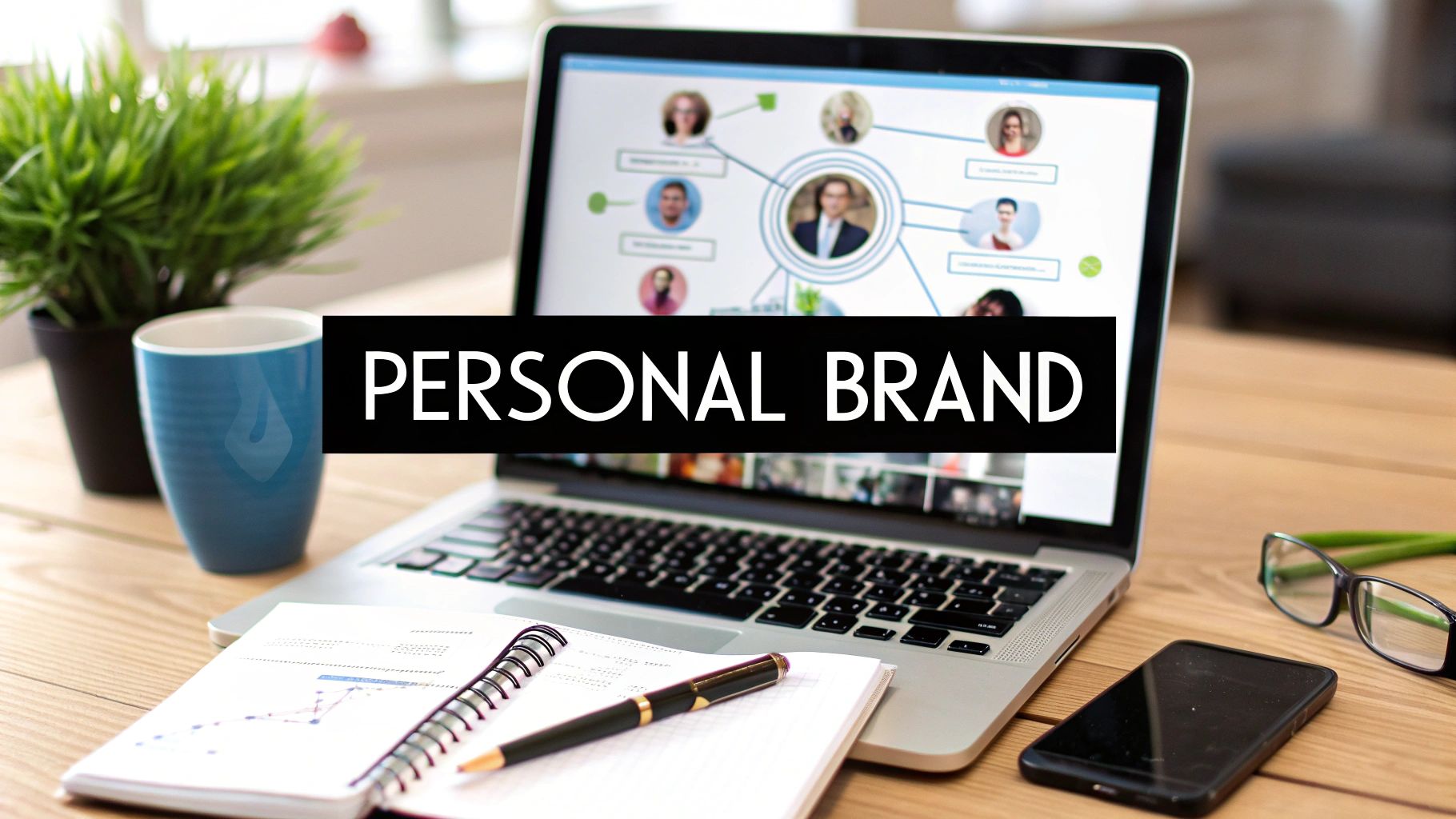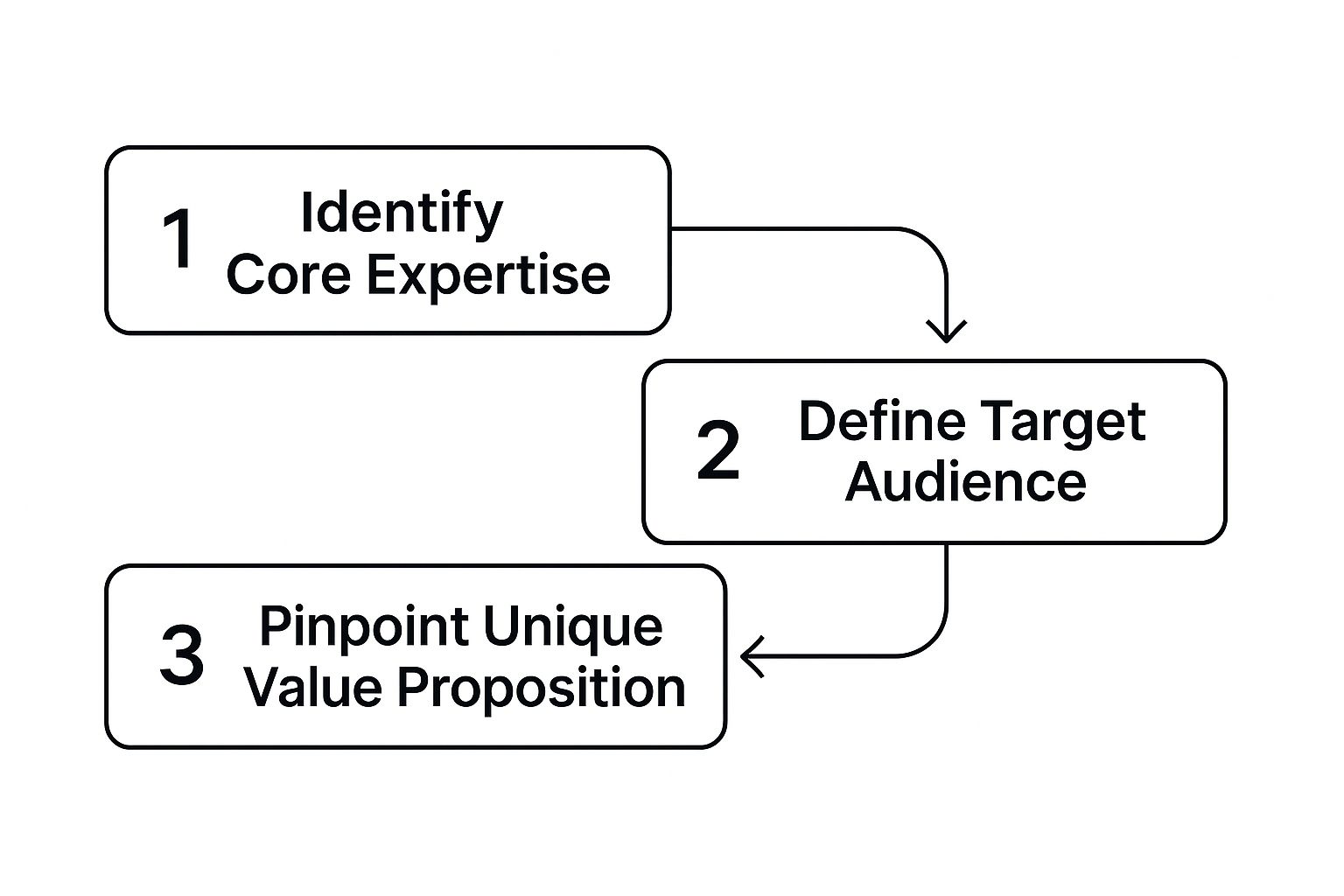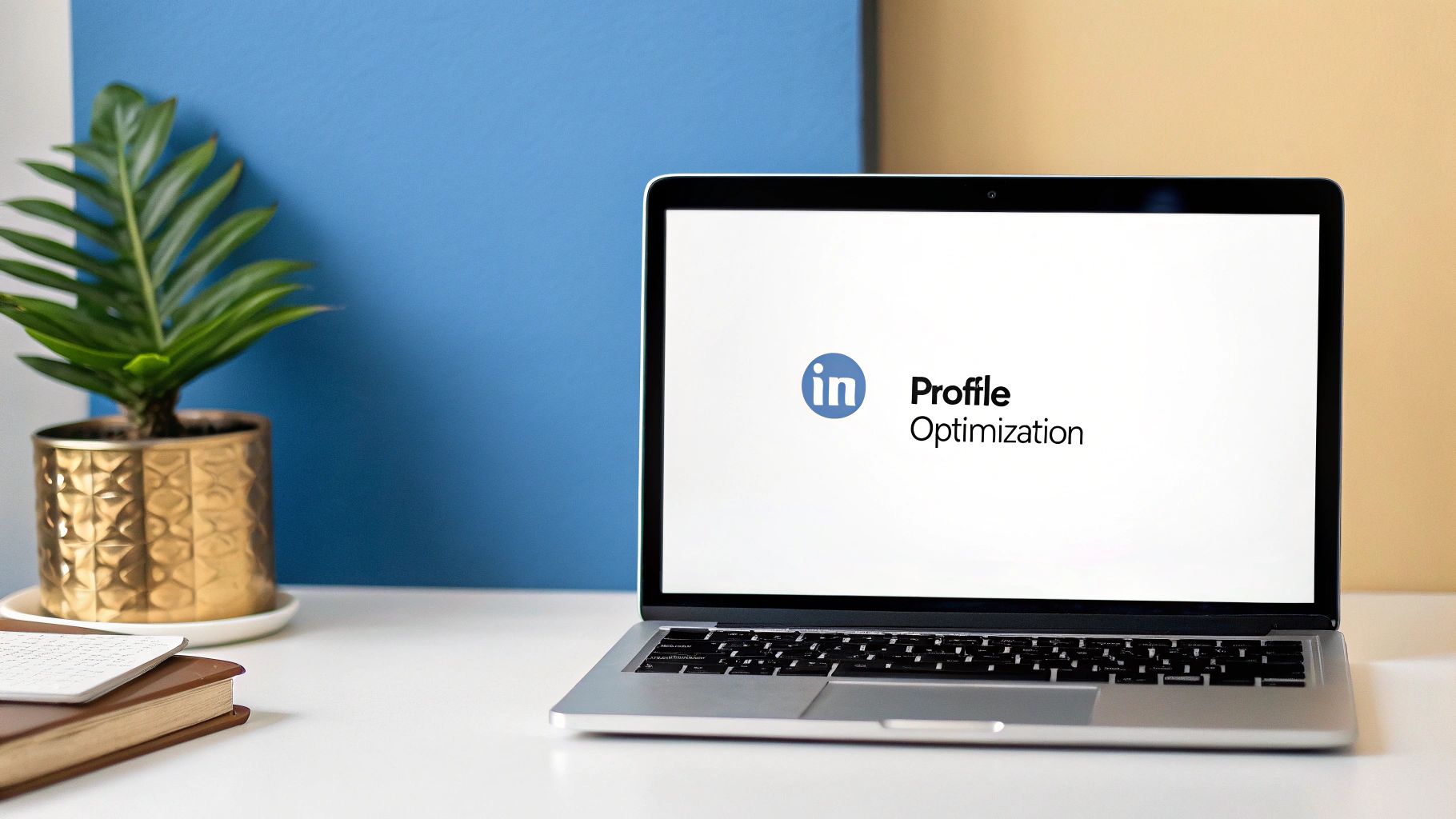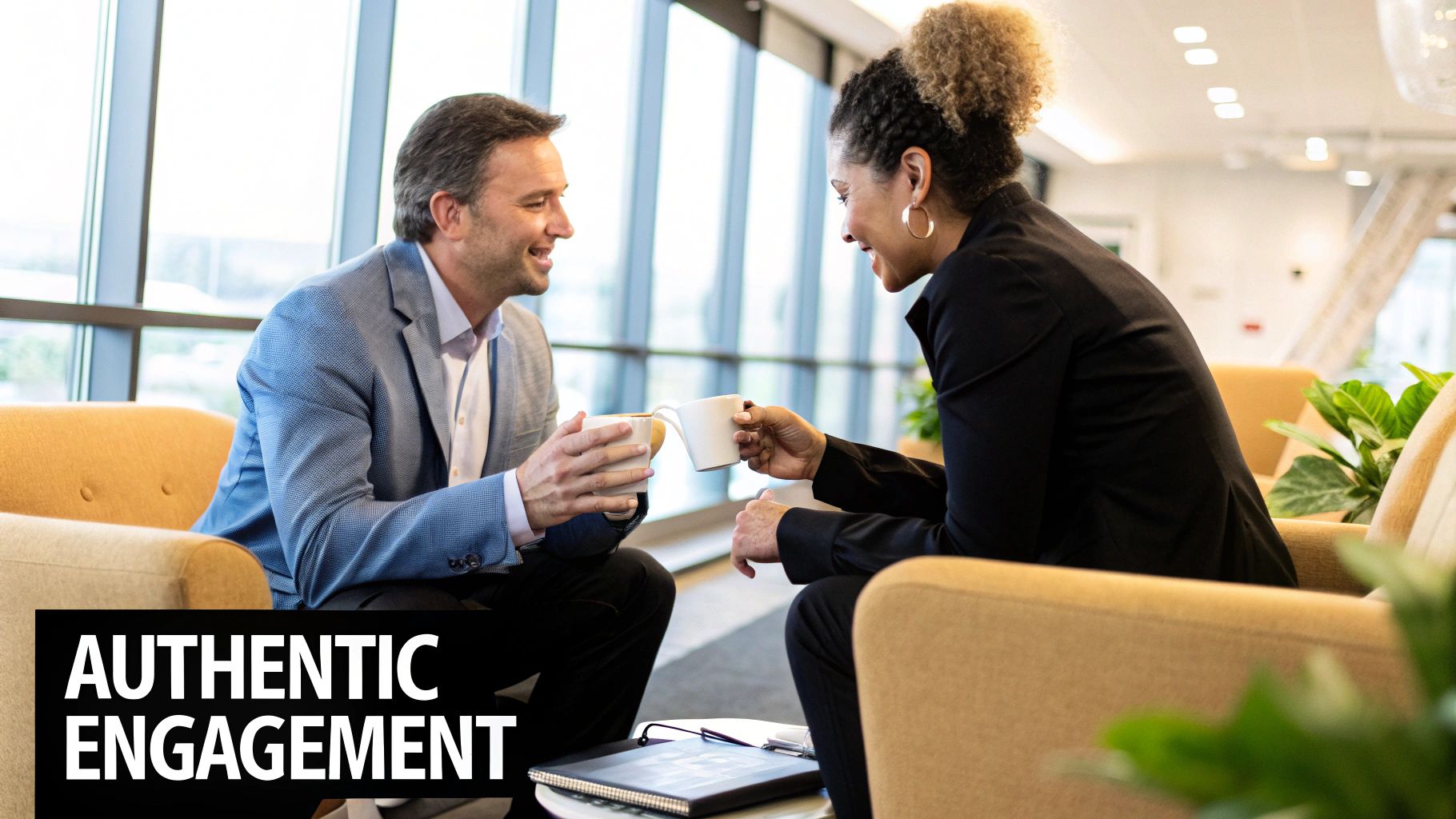
Your Guide to a Powerful LinkedIn Personal Brand
Published on 2025-10-21
Building your LinkedIn personal brand might just be the most powerful career move you can make. It’s how you turn a simple profile—basically a digital resume—into a living, breathing showcase of your expertise. You stop waiting for opportunities and start having them come directly to you.
Why Your LinkedIn Brand Is Your Biggest Career Move
A polished resume used to be enough to get you in the door. Not anymore. Today, your digital footprint makes the first impression, long before you ever shake a hand. A strong personal brand on LinkedIn tells your professional story—not just what you do, but who you are, what you stand for, and the unique value you offer.
Think of it like this: your resume lists your achievements, but your LinkedIn brand actually demonstrates them in real-time. It’s proof of your skills, your insights, and your influence in your field. And that active, engaged presence is exactly what recruiters and potential clients are looking for.
Moving Beyond a Digital Resume
A static profile is an invisible one. If you really want to stand out, you have to stop thinking of LinkedIn as just an online CV. It's a place to connect, share your ideas, and create your own opportunities.
Shifting your mindset is crucial. Here’s why:
- You build trust at scale. When you consistently share valuable content, you establish credibility. People start to see you as an expert before you’ve even had a conversation.
- Opportunities find you. A well-tended brand acts like a magnet. It pulls in recruiters, collaborators, and clients who are looking for exactly what you have to offer.
- It’s your professional safety net. A strong network and a respected brand give you career security. You become less vulnerable to layoffs or sudden market shifts because people know who you are and what you can do.
Your online presence often speaks for you before you get the chance to. An active, authentic brand makes sure it’s telling the right story—one of competence, value, and authority.
The numbers don't lie. Professionals with complete, optimized profiles are 40 times more likely to receive job opportunities. And when 70% of employers say a candidate's personal brand is more important than their resume, the message is crystal clear. Your online identity is your new career currency.
The Foundation of Modern Networking
At the end of the day, a strong LinkedIn brand is all about building real professional relationships. It lets you connect with peers, learn from leaders in your industry, and join conversations that actually matter.
Learning how to develop an effective LinkedIn lead generation strategy is a game-changer, whether you're hunting for clients or your next big career move.
The time you put into building your brand pays off by opening doors you never even knew were there. If you want to dive deeper into creating this digital footprint, our guide on how to build an online presence is the perfect next step. Trust me, your future self will thank you.
Crafting Your Unique Professional Story
Before you even think about your next LinkedIn post, we need to lay the groundwork. A standout personal brand isn't built on random updates or scattered thoughts. It’s built on a solid, strategic foundation. It all starts with getting crystal clear on who you are and what you stand for professionally.
Without this clarity, your content will feel disjointed, and your profile will just be another face in the crowd. Your goal is to stand out, not blend in. Let's build that essential framework together.
What’s Your Core Expertise?
First things first: what do you want to be known for? This isn't just your job title. Your core expertise is that sweet spot where your skills, passions, and real-world experience all come together.
Think about the problems you're always solving. What are the topics that colleagues, clients, or friends constantly ask you about? Don't just list every skill you have. Pinpoint the specialized knowledge that truly makes you different.
- A software developer might not just code; they specialize in "optimizing legacy code for fintech startups."
- A marketing manager isn't just a generalist; they're an expert in "building organic communities for B2B SaaS companies."
- An HR professional could focus on "implementing DE&I initiatives in remote-first organizations."
This kind of specialization makes you memorable and pulls in the right kind of audience.
Who Are You Talking To?
You can't be everything to everyone. It's a classic mistake, and it waters down your message until it’s meaningless. Instead, get laser-focused on exactly who you want to reach.
Ask yourself a few simple questions to nail this down:
- Who benefits most from what I know? (e.g., Early-stage founders, VPs of Sales, junior project managers)
- What industry are they in? (e.g., E-commerce, healthcare tech, renewable energy)
- What keeps them up at night? (e.g., Struggling with lead generation, managing hybrid teams, navigating career transitions)
When you know your audience inside and out, you can create content that speaks directly to their world. Suddenly, your insights become indispensable.
A strong personal brand doesn't shout into the void. It has a focused conversation with a specific group of people who are eager to listen because you understand their world.
The visual below shows how these core pieces fit together to create a solid brand foundation.

As you can see, your unique value truly shines when your expertise directly solves a problem for your specific audience.
What’s Your Unique Value Proposition?
This is the heart of your professional story. Your unique value proposition (UVP) is the simple, clear answer to the question: "Why should I follow, connect with, or hire you?"
Your UVP brings together your expertise and the specific results you deliver for your audience. It’s the promise you make.
For instance, "I'm a content marketer" is forgettable. But what about this? "I help early-stage B2B tech founders build trust and generate leads through compelling storytelling, turning complex ideas into content that converts." Now that is powerful and specific. Storytelling is a massive part of this, and looking at different business storytelling examples can give you fantastic ideas for your own narrative.
To help you put all these pieces together, I've created a simple worksheet. Use this table to map out your brand's core components and get clear on your professional positioning.
Personal Brand Blueprint Worksheet
| Brand Component | Guiding Question | Your Answer (Example) |
|---|---|---|
| Core Expertise | What specific skill or knowledge area do I want to be known for? | B2B SaaS content marketing |
| Target Audience | Who are the specific people I want to help? | Early-stage B2B tech founders |
| Audience Pain Point | What is their biggest professional challenge? | Generating leads and building trust with a limited budget |
| Unique Value Prop | How do I solve their problem in a unique way? | I use storytelling to turn complex tech into content that converts leads. |
Filling this out gives you the three pillars of your brand: expertise, audience, and value. This professional story will become your North Star, guiding every post you create and every comment you leave, ensuring your LinkedIn presence is both genuine and strategic.
Optimizing Your Profile for Maximum Impact

Think of your LinkedIn profile as your digital storefront. It’s the first place anyone—a recruiter, a potential client, a future collaborator—will go to vet you. It needs to do more than just list your work history; it has to tell your professional story, prove your value, and build immediate trust.
An unpolished profile is a dead end. But a great one? It’s a magnet for the exact opportunities you want. Let's dig into how to turn every piece of your profile from a static placeholder into a dynamic asset for your linkedin personal brand.
Your Visual First Impression
Long before anyone reads a single word, they see your headshot and banner. These two visuals set the entire tone. Get them wrong, and you've lost your audience before you've even started.
Your profile picture needs to be a high-quality, professional headshot. Simple as that. You should look confident and approachable. This isn’t the place for that great vacation photo or a blurry picture cropped from a group shot. That single image is a massive trust signal.
And that big banner image at the top? That’s prime real estate. Leaving it as the default blue background is a huge missed opportunity. Use it to:
- Broadcast your value: Add a simple line of text that says who you help and what you do for them.
- Reinforce your brand: Use colors and fonts that feel like you or align with your company's look.
- Give a clear next step: Point people toward your website, newsletter, or portfolio with a call to action.
Together, these elements create a professional, cohesive look that screams credibility from the get-go.
Crafting a Headline That Gets Clicks
Your headline is arguably the most critical text on your entire profile. It follows you everywhere—in search results, connection requests, and every comment you leave. It must do more than just state your job title.
A truly effective headline is a mini-pitch packed with keywords your target audience is actually searching for.
So instead of "Marketing Manager at Company X," you could try something like this:
"B2B SaaS Content Strategist | Helping Tech Startups Drive Organic Growth & Convert Leads | SEO & Storytelling"
See the difference? This version doesn't just say what you do; it explains who you help and the results you deliver. For a deeper dive into these nuances, you can learn how to optimize your LinkedIn profile with a focus on your headline and summary.
Telling Your Story in the About Section
This is where you get to expand on that killer headline. The "About" section is your chance to connect with people on a human level, using your own voice. Please, don't just list your skills. Weave them into a compelling story.
A good way to structure it is:
- Hook them immediately: Open with a strong, confident statement about the value you bring.
- Define your audience: Clearly state who you help and what problems you solve for them.
- Explain your "how": Briefly describe your process, skills, and unique approach.
- Show, don't just tell: Drop in a few specific achievements, powerful metrics, or quick case study highlights.
- End with a call to action: Tell people what you want them to do next. Connect? Visit your site? Message you?
I’ve found that breaking up the text with short paragraphs, bullet points, or even the right emoji makes it far more readable. The goal is for someone to scan it and immediately get what you're all about. If you're starting from scratch, our complete guide can help you build a LinkedIn profile that truly captures your brand.
Showcasing Your Best Work
The "Featured" section is your personal highlight reel. It’s a highly visual spot right near the top of your profile where you can pin your absolute best work. Use it to give people tangible proof of your expertise.
Some great things to feature include:
- Your top-performing LinkedIn posts or articles.
- Links to your personal website, portfolio, or a key project.
- Case studies or client testimonials that demonstrate real results.
- Podcast interviews, webinar recordings, or other media mentions.
This section is what turns your claims of expertise into cold, hard proof. It's a massive credibility builder.
The numbers don't lie. A professional photo can get your profile 14 times more views, and simply having a current job listed can boost connection requests by up to 5 times. With over 1 billion members on the platform now, making sure your profile is polished isn't just a good idea—it's essential for getting seen.
Developing a Sustainable Content Strategy

A killer profile gets people in the door, but it’s your content that makes them pull up a chair and stay a while. Think of your posts as the engine driving your LinkedIn personal brand. Without them, you’re just a static resume. With them, you become an active, recognized authority in your field.
The secret isn’t just posting; it’s posting with purpose and finding a rhythm you can actually maintain for the long haul.
A lot of people I talk to get paralyzed by the idea of content creation. They imagine needing to write massive, groundbreaking articles every week. That’s just not true. Most effective LinkedIn content is short, insightful, and pulled directly from the expertise you already have. It's about sharing what you know to help people out.
The real goal here is to find your voice and build a simple framework that makes creating content feel less like a chore and more like a natural part of your work week.
Finding Your Content Pillars
Your content needs a theme. If you’re just posting randomly, your audience will never know what to expect from you, and they won't have a reason to follow. This is exactly why you need content pillars. These are 2-4 core topics—the things you can talk about all day long—that form the foundation of everything you post.
Go back to that "Unique Professional Narrative" we talked about earlier. Your pillars should be a direct extension of your core expertise and the problems your audience is trying to solve.
Let’s say you’re a content strategist for B2B SaaS companies. Your pillars might look something like this:
- SEO for Startups: Actionable tips for founders who don’t have a huge budget.
- Content That Converts: Frameworks for turning blog posts into actual leads.
- Building a Brand Voice: How to sound unique when everyone else sounds the same.
- Marketing Productivity: Tools and workflows that help you get more done.
Suddenly, brainstorming gets a lot easier. Instead of staring at a blank page, you can just ask yourself, "What's one helpful tip I can share about SEO for Startups today?"
Choosing the Right Content Format
LinkedIn gives you a whole toolbox of content formats, and each one has a different job. Mixing them up keeps your feed from getting stale and helps you connect with people in different ways. Don't feel like you need to be a master of all of them. Just start with one or two that feel comfortable.
Text-Only Posts
These are the absolute workhorses of LinkedIn. They're fast to create, easy for people to read, and perfect for sharing a quick thought, asking a question, or telling a short story. Their simplicity is their strength—they feel personal and conversational, which often drives great engagement.
Image or Carousel Posts
Visuals are professional-grade scroll-stoppers. Use a single, powerful image to drive a point home, or create a carousel (which is just a multi-page PDF) to break a complex idea down into simple, swipeable steps. I find carousels work incredibly well for tutorials, checklists, or turning a big idea into something bite-sized.
Video Content
Nothing builds trust faster than video. A quick, unpolished video of you sharing a tip or giving a behind-the-scenes look at a project can do wonders for humanizing your brand. You don’t need a fancy studio; your smartphone is more than enough to get started.
The best content format is the one you will consistently create. Don't force yourself to make videos if you hate being on camera. Start with what feels easy—text or simple images—and you can always branch out later as you get more confident.
Creating a Realistic Posting Schedule
Consistency will beat intensity every single time. Posting five times in one week and then going dark for a month just doesn’t work. The LinkedIn algorithm rewards regular activity, and more importantly, your audience wants reliability. The whole game is about building a schedule you can stick to without burning out.
So, how often should you post? One analysis of 100 highly-engaged profiles found that 72% of top creators post at least once every two days. But you don't need to start there. Honestly, just posting 1-2 quality posts per week is a fantastic start that will put you way ahead of most people. If you're curious, you can find more data about LinkedIn posting frequency to help find your sweet spot.
Here’s a simple way to get into a rhythm:
- Batch Your Ideas: Set aside 30 minutes once a week just to brainstorm ideas related to your content pillars.
- Draft in Advance: Spend an hour writing out your 2-3 posts for the week ahead.
- Schedule or Post Live: You can use a scheduling tool to automate it or just set reminders on your phone to publish your content when your audience is most active.
This system takes away the daily pressure of trying to be brilliant on demand. It turns content creation from a chaotic scramble into a calm, proactive system that builds your brand one post at a time.
Growing Your Influence Through Real Engagement

Putting out great content is a fantastic start, but it's only half the equation. If you just post and ghost, you’re missing the point. LinkedIn isn't a megaphone to shout into; it’s a conference room filled with people ready to talk. Your LinkedIn personal brand truly comes to life when you build genuine, two-way connections.
Engagement is what breathes life into your profile, turning it from a static resume into a lively hub for conversation. This is how you build actual relationships, earn trust, and get your content in front of the right people.
Grow Your Network with Purpose
Forget the old spray-and-pray approach to connections. A huge network of people you don't know and who don't care about your work is just digital clutter. The real magic happens when you build a focused, engaged community.
Aim for quality, not quantity. Your goal should be to connect with peers, potential clients, and industry thinkers who actually fit into your professional world.
And please, always personalize your connection requests. A generic invite is forgettable. A short, thoughtful note shows you've actually paid attention.
- Find a shared interest: "Hey Jane, I saw your post on sustainable supply chains and loved your take. I'm also really focused on this area and would be great to connect."
- Acknowledge their work: "John, that case study your team just published was fantastic. The results were impressive. Hope you don't mind the connection—I'd love to follow your work."
- Look for common ground: "Hi Sarah, I noticed we both attended the Marketing Summit last year. It would be great to connect and swap notes."
This one simple step makes a world of difference. It boosts your acceptance rate and kicks off the relationship with respect and a human touch.
Master the Art of the Value-Driven Comment
One of the most overlooked—and powerful—strategies on LinkedIn is leaving thoughtful comments. I'm not talking about the generic "Great post!" drive-by. I mean adding real substance to the conversation.
When you see a post from someone you admire or a potential client, pause for a moment. Leave a comment that does one of these things:
- Ask a smart question that takes the discussion deeper.
- Share a quick, relevant story from your own experience that backs up their point.
- Offer a different perspective—but always do it constructively and respectfully.
A well-crafted comment gets you noticed by the original poster and everyone else in their audience. It's like a mini-demonstration of your expertise. You can build an incredible reputation this way, sometimes without even publishing your own posts.
Your comments are a direct reflection of your brand. Each one is a small chance to showcase what you know, who you are, and that you're here to have a meaningful conversation.
Be Personal, Not Private
Authenticity is the currency of a strong personal brand today. People want to connect with other people, not a polished, corporate-sounding bot. Sharing your professional journey—the wins, the lessons learned, and even the occasional misstep—is what makes you relatable.
The new gold standard is to be 'personal, not private.' It's about sharing experiences that build trust without getting into TMI territory. For instance, a leader could share what they learned from a lost client pitch—the mistake and the fix—but would steer clear of personal gossip. This balance is key, as you can find more expert advice on building a modern personal brand at pettauer.net.
Think about sharing a story of a project that went sideways and what you took away from it. Or maybe talk about a career hurdle you overcame. This kind of vulnerability doesn't make you look weak; it shows you're a real person with real experience. It’s what turns passive followers into a loyal community that genuinely roots for you.
Got Questions About LinkedIn Branding? Let's Get Them Answered.
Jumping into personal branding on LinkedIn can feel like you’re trying to solve a puzzle with a few missing pieces. It’s natural to have questions, and trust me, you're not the first to ask them.
Let's cut through the noise and tackle the most common questions I hear. My goal is to give you straightforward, practical answers so you can start building your brand with a clear head.
"How Often Should I Really Be Posting on LinkedIn?"
This is hands-down the most popular question. The answer isn't a magic number, but a simple principle: consistency beats frequency, every single time.
Think about it. Posting like a machine for one week and then going silent for a month confuses both the algorithm and your audience. People—and platforms—value reliability.
If you’re just starting out, aim for two to three quality posts a week. That’s a solid, manageable rhythm that keeps you on people’s radar without burning you out. As you get comfortable, you can adjust. Some fast-paced industries might call for daily updates, while others respond better to more thoughtful, less frequent posts.
Find a schedule you can actually stick with for the long haul. That's the real secret.
"What If I Feel Like I Have Nothing to Post?"
So many people get stuck here, but it's a mental block, not a reality. You know more than you think. Your day-to-day work, your unique perspective, the problems you solve—that’s your content goldmine.
You don't have to write a groundbreaking thesis every time. Just start documenting your work. Try one of these ideas:
- Share a recent win: What did you achieve this week? More importantly, what did you learn from it?
- Talk about a challenge: What problem did you have to untangle? Walk people through your thought process.
- Give a quick tip: What’s one small piece of advice you’d offer someone just starting in your field?
- Offer a hot take: What do you think about that new industry trend or a recent article everyone’s sharing?
Your daily work is packed with valuable insights. The trick isn't creating new knowledge from scratch; it's learning to recognize and share the expertise you already use every day.
Remember, even if a topic has been covered before, your personal take is what makes it fresh and valuable. That’s how you build a brand.
"Does My Follower Count Actually Matter?"
Let's be honest, seeing that number go up feels good. But while a big follower count can expand your reach, it's often just a vanity metric.
What truly matters is the quality of your followers, not the quantity. I’d take a small, highly engaged audience of a few hundred relevant people over a passive crowd of 10,000 any day.
Focus your energy on connecting with people who are:
- Peers in your industry
- Potential clients or employers
- Leaders you genuinely admire
- People who actually comment on and share your stuff
When you consistently provide value, your follower count will take care of itself. Chasing numbers is a losing game. Building a real community is how you win.
And winning on LinkedIn is getting more competitive. In 2025, there are an estimated 2.5 applicants for every single job posting, a huge jump from 1.5 back in 2022. Building a brand is no longer a "nice-to-have." It’s how you stand out, especially since only 7% of LinkedIn's billion-plus users are actively job hunting. The rest are there to connect and learn, making it the perfect place to establish yourself as an authority. You can discover more insights about the 2025 personal branding playbook to get ahead of the curve.
At the end of the day, building a brand is a marathon, not a sprint. Focus on being consistent, sharing what you truly know, and building a network of quality connections. Do that, and you’ll create a professional presence that opens doors you never knew existed.
Ready to stop guessing and start creating content that builds your brand? autoghostwriter uses powerful AI to help you generate authentic, scroll-stopping LinkedIn posts in minutes. Take the guesswork out of content creation and build your brand with us.